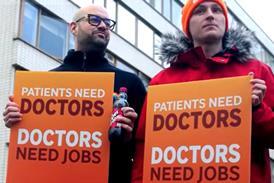- Senior figures said 19 patients being treated at temporary Nightingale hospital over the weekend
- Docklands facility designed to have 2,900 intensive care beds
- Data seen by HSJ suggests London’s established hospitals have doubled their ICU capacity, and are so far coping with surge
London’s Nightingale hospital has remained largely empty, with just 19 patients being treated at the facility over the Easter weekend, HSJ understands.
According to draft plans, the temporary hospital in the Docklands was designed to have 2,900 intensive care beds, along with 750 further beds.
In early March, there were fears the capital’s existing intensive care units, which had around 770 beds combined, would be overwhelmed by coronavirus patients. This prompted national and regional leaders to target a four-fold increase in ICU capacity, and to build the Nightingale at the Excel conference centre.
However, internal data circulated to senior leaders over the Easter weekend, and seen by HSJ, suggested the established hospitals have been able to double their ICU capacity on their existing estates, raising the total available ICU beds to 1,555.
The same data showed 1,245 of these beds were occupied on Easter Sunday (80 per cent), suggesting the established hospitals have so far been able to cope with the surge in demand, without relying on large numbers being admitted to the Nightingale.
HSJ has seen data showing 19 patients were at the London Nightingale over the bank holiday, which has been confirmed by a senior figure who did not want their name to be published.
The low numbers at the Nightingale are also likely to be influenced by the tight criteria that was agreed for patients to be admitted there, which excluded the most frail patients.
According to the circulated data, south west London had the most spare capacity, with 67 per cent of ICU beds occupied on Sunday. At Croydon Health Services Trust, just 46 per cent of the 37 intensive care beds were occupied.
North London had the least spare capacity, with 204 beds (86 per cent) occupied.
There were two trusts with more than 90 per cent occupancy: Imperial College Healthcare Trust (95 per cent) and University College London Hospitals Foundation Trust (91 per cent).
An NHS England spokesman said: “While the data quoted here are not complete and validated, they confirm continuing success in ensuring we have available capacity to look after patients who need our care, which has been one of our overarching operational goals since the start of the coronavirus pandemic.”
Source
Information provided to HSJ
Source Date
12 April 2020



























18 Readers' comments